DACF Home → Bureaus & Programs → Maine Natural Areas Program → Communities, Plants, and Animals → Invasive Plants → Common Reed
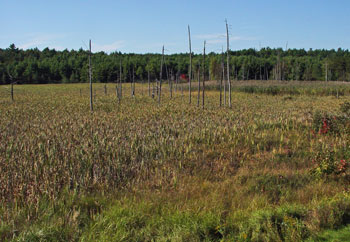 Phragmites (in back right of photo) invading a freshwater marsh
Phragmites (in back right of photo) invading a freshwater marsh
Common Reed
(Phragmites)
Phragmites australis
2019 Status in Maine: Widespread. Severely Invasive.
Description: Very tall (to 13') perennial grass growing in dense stands. Leaves: Alternate, entire, yellow-green to greenish-blue, widest in middle, tapering toward pointed tip, very long (~8-15"). Flowers/Seeds: "Fluffy" seed heads start brown-purple, then turn light tan over the fall, persisting through winter. Stem: Round, hollow, with nodes where leaves meet the stem. Dead, tan stalks persist through winter. Rhizome: Dense mat of coarse interconnected roots.
Native range: Europe. How arrived in U.S.: Probably via ship ballast water.
Reproduction: By seed, or by fragments of rhizome dispersed in fill or by water. There are reports of seed banking but length of time is unknown. It can sprout from any rhizome fragment.
Habitat: Open wetlands and wet ditches. Especially damaging in saltmarshes and freshwater marshes. It also frequently grows in roadside ditches and swales.
Similar native species: Native Phragmites americanus can be difficult to distinguish from the invasive P. australis. The native, which is infrequent in Maine, typically grows in small, diffuse stands (not dense) and is comparitively short at ~6'. Also, the middle and upper internodes of P. australis are dull, ridged, and tan during growing season, while P. americanus has smooth, lustrous, red-brown to dark red-brown middle and upper internodes. The native typically grows in fens and tidal marshes, not in disturbed areas.
 P. australis, invasive, on left; P. americanus, native, on right
P. australis, invasive, on left; P. americanus, native, on right
Similar non-native species: No other non-native grass is so tall. Escaped Miscanthus ornamental grasses are showy but do not normally occur in wetlands.
Documented Ecological Impacts
- Common reed is considered an ecosystem engineer, and large stands can alter plant diversity, soil properties, sedimentation rates, bird and fish habitat use, and food webs. (Gucker, C.L. 2008. Phragmites australis. In: Fire Effects Information System. U.S. Department of Agriculture, Forest Service)
- The altered vegetation structure in common reed stands can lead to decreases in rare specialist saltmarsh birds. (Benoit, L.K. and R.A. Askins. 1999. 1999. Impact of the spread of Phragmites on the distribution of birds in Connecticut tidal marshes. Wetlands 19:194-208)
- Native fish abundance, especially for juvenile and larval fishes, is decreased in marshes dominated by common reed, at least in part due to the increased leaf litter produced by common reed which reduces juvenile fish mobility. (Rose, E.E. 2019. A review of the ecological effects of European common reed (Phragmites australis) on fishes and fish habitat in North America. Journal of Student Science and Technology and Croft-White et al.. 2021. Fish composition, but not richness or abundance, differ among Phragmites, Typha, and Schoenoplectus zones during a high-water year)
- Common reed stands can decrease available turtle nesting habitat, threatening the reproductive success of some turtles, including Blanding's turtle (Endangered in Maine). Bolton, R.M. 2010. Impact of the seasonal invasion of Phragmites australis (common reed) on turtle reproductive success. Chelonian Conservation and Biology 9:238-243 and Markle, C.E. and P. Chow-Fraser. 2018. Effects of European common reed on Blanding’s turtle spatial ecology. Journal of Wildlife Management 82:857-864)
- Common reed can hybridize with the native species, reducing native genetic diversity and leading to the decline of native Phragmites americanus lineages.(Saltonstall, K. et al. 2014. Confirmed field hybridization of native and introduced Phragmites australis (Poaceae) in North America. American Journal of Botany 101:211-215)
- The Maine Natural Areas Program has documented common reed invading rare salt-hay saltmarsh natural communities in Maine, a top concern for conservation of biodiversity.
Fact Sheets and Identification Links
- Vermont Fact Sheet for Common Reed (Phragmites)
- Tip of the Mitt Watershed Council, Minnesota, Identification Video (5:50)
- Beaver Island, Michigan (10:00), identification, ecology, hand tools, disposal, and herbicide application
- Purple Loosestrife: What You Should Know, What You Can Do
- A Guide to the Control and Management of Invasive Phragmites, Michigan DNR
- Go Botany page for Phragmites australis
Control Methods
Small patches (<50' radius) can be cut repeatedly throughout the growing season*, as often as once every two weeks, for multiple years (~5-10 years), depleting root reserves and preventing flowering. This method requires diligence. Larger patches are very difficult to control manually without a persistent, reliable labor source. Herbicides† are effective (though follow-up will be needed). The cut-drip method is preferred in small stands (<1 ac) as it is the most precise treatment: bundle and tape 5-10 stems (masking tape works well), cut* live stems late in the growing season, then spray or drip aquatic-formulation glyphosate, with tracer dye, onto cut surface. Foliar application of aquatic-formulated glyphosate can also be effective. If possible, follow up by conducting a controlled burn in the spring following the herbicide application; this can remove old thatch and encourage native plant regeneration. Special rules apply to herbicide use in or near wetlands and water bodies - consult the Maine Board of Pesticides Control.
* Correctly dispose of all plant parts↵ † Follow all label directions when using herbicides↵Control Technique Video Demonstrations
- Beaver Island, Michigan (10:00), identification, ecology, hand tools, disposal, and herbicide application
Please email invasives.mnap@maine.gov if you have questions about invasive species in Maine
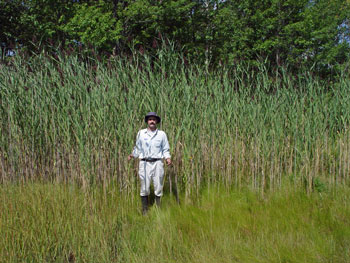 Summer stand of Phragmites
Summer stand of Phragmites
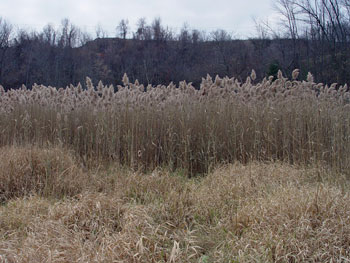 Fall stand of Phragmites
Fall stand of Phragmites
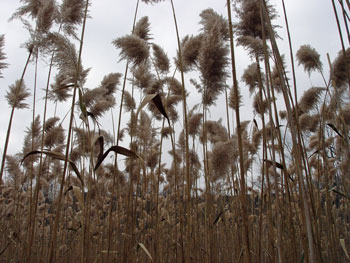 Phragmites seed heads
Phragmites seed heads
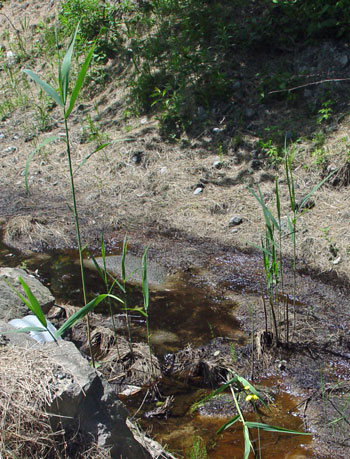 Phragmites-new shoots
Phragmites-new shoots